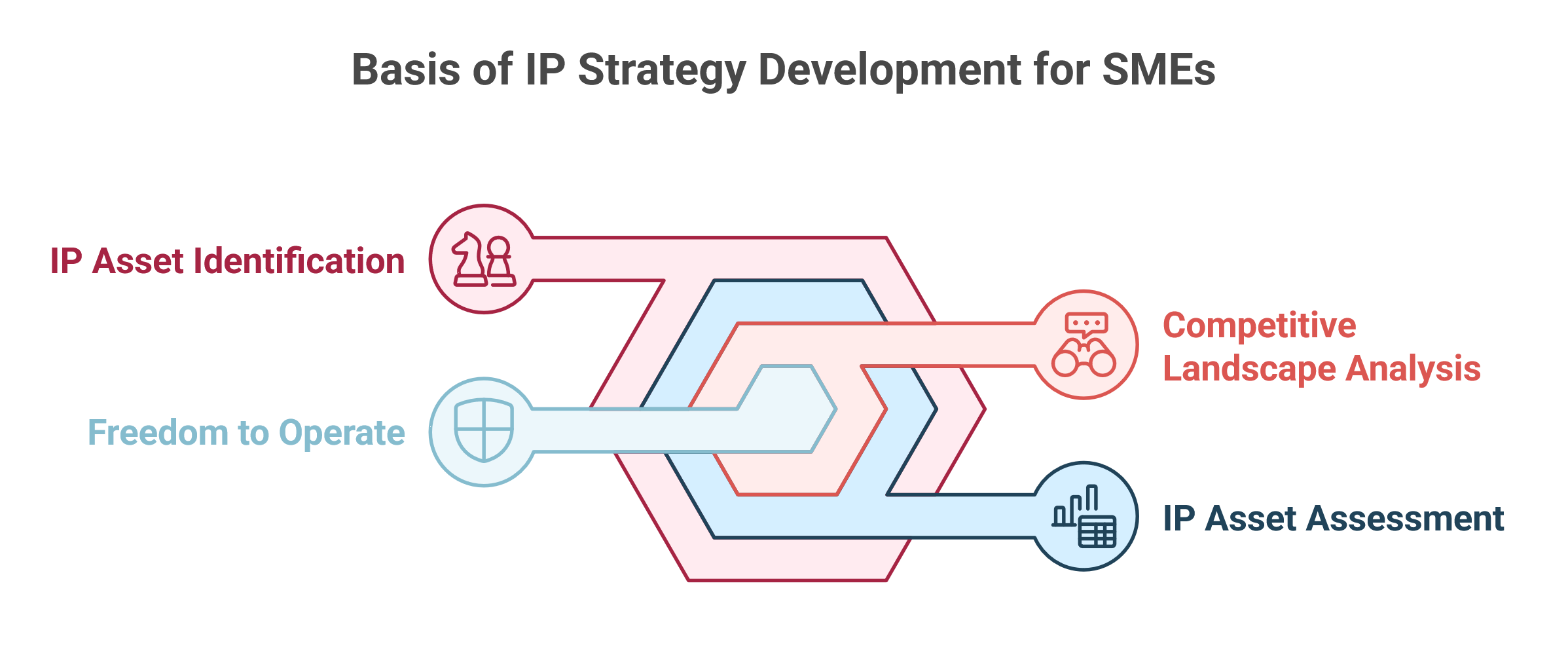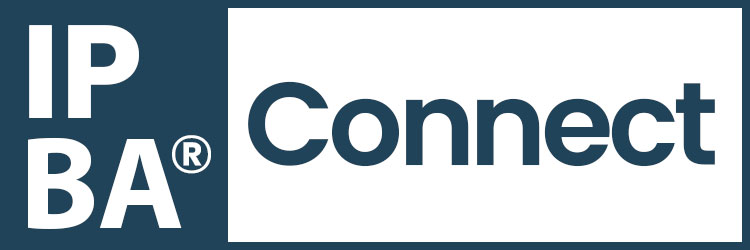
Developing a robust IP strategy👉 Approach to manage, protect, and leverage IP assets. begins with a comprehensive understanding of the intellectual property👉 Creations of the mind protected by legal rights. assets within an SME. This involves a meticulous process of identification, assessment, and prioritization. It’s akin to conducting a thorough inventory audit; businesses must recognize the valuable assets they possess, their significance, and their potential impact on the company’s trajectory.
Identifying your IP assets
The foundation of any successful IP strategy lies in a thorough understanding of the intellectual property assets within an SME. This initial phase focuses on systematically identifying and documenting all forms of IP that the business owns or has the right to use. It’s akin to conducting a comprehensive inventory audit; businesses must recognize the valuable assets they possess, understand their nature, and appreciate their potential impact on the company’s growth and market position.
This process necessitates a meticulous examination of all facets of the business, encompassing its operations, products, and services. The objective is to pinpoint the elements that distinguish the SME’s offerings and contribute to its unique brand👉 A distinctive identity that differentiates a product, service, or entity. identity. Key areas to investigate during this identification phase include:
1. Unique product or service attributes
Scrutinizing the features that set the SME’s products or services apart is crucial. This involves identifying any unique attributes that could be protected as intellectual property.
Inventions
Does the SME possess any novel inventions👉 A novel method, process or product that is original and useful., innovative technologies, or unique processes?
These could be protected through patents, providing exclusive rights to the invention for a defined period.
Designs
Does the SME have distinctive product designs, unique packaging, or original graphical user interfaces?
These visual elements can be protected through design rights, preventing others from copying the appearance of the product.
Trade secrets
Does the SME possess confidential information, such as manufacturing processes, formulas, or customer lists, that provide a competitive edge?
These valuable assets can be protected as trade secrets, provided they are kept confidential and provide economic value.
2. Creative works
Identifying all creative works generated by the SME is essential. This encompasses a wide range of assets that are typically protected by copyright👉 A legal protection for original works, granting creators exclusive rights..
Marketing and branding
This includes marketing collateral such as brochures, advertisements, website content, and social media posts.
Original text, images, and videos used in marketing efforts are all eligible for copyright protection.
Software and technology
Software code, databases, and algorithms developed by the SME are valuable IP assets.
Copyright protection can prevent unauthorized copying, distribution, and modification of these works.
Artistic and literary works
This category includes any original artwork, photographs, music, or written content created by the SME or its employees.
These works are automatically protected by copyright upon creation.
3. Brand identity
Protecting the SME’s brand identity is crucial for building customer recognition and loyalty.
Trademarks
Does the SME have a distinctive brand name, logo, or slogan?
These elements can be protected through trademark👉 A distinctive sign identifying goods or services from a specific source. registration, preventing others from using similar marks that could cause confusion in the marketplace.
Domain names
The SME’s website address is a valuable asset that can be protected.
Registering and maintaining domain names helps ensure that customers can easily find the SME online.
4. Maintaining an overview of existing IP protection
Beyond identifying potential IP assets, it’s crucial for SMEs to maintain a clear overview of their existing IP protection. By maintaining a comprehensive overview of their existing IP protection, SMEs can ensure that their valuable assets are properly managed and protected. This allows them to leverage their IP effectively, mitigate risks, and make informed decisions about future IP strategy.
This involves:
Documenting existing IP rights
Maintaining detailed records of all registered IP rights, including patents, trademarks, and design rights.
This should include information such as application dates, registration numbers, and expiration dates.
Matching with products and/or product features
In order to maintain an accurate overview of which products, product parts, product features, etc. are protected against imitation by unauthorised third parties, it is essential to assign IP rights, in particular patents, to these assets.
This ensures that the company retains permanent knowledge of what exactly is and is not protected.
Tracking legal status
Regularly monitoring the legal status of IP rights is essential.
This includes tracking renewal deadlines, monitoring for potential infringements, and staying informed about any changes in IP law.
Centralized IP management
Implementing a centralized system for managing IP assets can help SMEs maintain an organized and accessible record of their IP portfolio.
This could involve using spreadsheets, databases, or specialized IP management👉 Strategic and operative handling of IP to maximize value. software.
In conclusion, identifying your IP assets is the first critical step in developing a robust IP strategy. By diligently examining all aspects of the business, including products, services, creative works, and brand identity, SMEs can gain a clear understanding of their IP landscape. Furthermore, maintaining a well-organized record of existing IP protection ensures that these valuable assets are effectively managed and leveraged for business growth.
Assessing your IP assets
Once potential IP assets are identified, the next step is to evaluate their value and significance to the business. This assessment involves a multifaceted approach, considering various factors that influence the asset’s overall worth.
Key assessment criteria include:
Strength of the IP
Evaluating the uniqueness and defensibility of the IP is paramount.
This involves determining the novelty👉 Requirement that an invention must be new and not previously disclosed. of an invention, the distinctiveness of a brand, or the originality of a creative work. Strong IP with clear differentiators is more valuable and easier to protect.
Commercial value
Assessing the revenue generation potential or market share contribution of the IP is essential.
This includes analyzing how the IP influences brand reputation, customer loyalty, and overall market positioning. IP with high commercial value warrants greater protection and strategic utilization.
Lifespan of the IP
Considering the duration of relevance and value for the IP is crucial. Some IP, particularly in fast-paced industries, may have a limited lifespan due to rapid technological advancements or evolving consumer preferences.
Understanding the IP’s lifecycle helps in making informed decisions about investment in its protection and exploitation.
This comprehensive assessment facilitates the prioritization of IP assets. SMEs can identify the most crucial assets that require robust protection and strategic management👉 Strategic management is the process of planning, implementing, and evaluating. to maximize their potential.
Analyzing your competitive landscape
Understanding the IP landscape within which the SME operates is vital. This involves analyzing the competitive environment to identify potential risks and opportunities related to IP.
Key aspects of competitive analysis include:
Competitor IP
Identifying the IP held by competitors provides valuable insights.
This includes monitoring their patent👉 A legal right granting exclusive control over an invention for a limited time. and trademark filings to understand their technological advancements and branding strategies. It helps SMEs anticipate potential challenges and identify areas for differentiation.
Dominant players
Recognizing dominant players with extensive IP portfolios is essential.
Analyzing their IP can reveal potential barriers to entry, areas of potential infringement👉 Unauthorized use or exploitation of IP rights., and opportunities for collaboration or licensing👉 Permission to use a right or asset granted by its owner..
Emerging technologies and trends
Staying abreast of emerging technologies and industry trends is crucial.
This allows SMEs to adapt their IP strategies, identify new areas for innovation👉 Practical application of new ideas to create value., and protect their IP from becoming obsolete.
By understanding the competitive landscape, SMEs can make informed decisions about their IP strategy, mitigate risks, and leverage opportunities to enhance their market position.
Considering Freedom to Operate👉 Strategic analysis to determine whether a product or service might infringe existing IP rights. (FTO)
Freedom to operate (FTO) refers to an SME’s ability to conduct its business activities without infringing upon the IP rights of others. Ensuring FTO is critical to avoid costly legal disputes and potential disruption of business operations.
Key steps to ensure FTO include:
IP clearance searches
Conducting comprehensive searches of existing patents, trademarks, and copyrights is crucial.
This helps identify potential conflicts with existing IP rights and ensures that the SME’s products, services, and branding do not infringe upon others’ intellectual property.
Legal counsel
Seeking legal advice from an IP attorney is highly recommended, especially when complexities arise or potential infringement risks are identified. IP attorneys can provide expert guidance on navigating legal issues, mitigating risks, and developing strategies to ensure FTO.
By proactively addressing FTO, SMEs can minimize the risk👉 The probability of adverse outcomes due to uncertainty in future events. of legal challenges, protect their business operations, and foster a culture of respect for intellectual property rights.

In conclusion, understanding your IP assets is the cornerstone of a successful IP strategy. By diligently identifying, assessing, and prioritizing IP, analyzing the competitive landscape, and ensuring freedom to operate, SMEs can gain a comprehensive understanding of their IP position. This knowledge empowers them to make informed decisions about leveraging their intellectual property for business growth, innovation, and sustainable competitive advantage.
